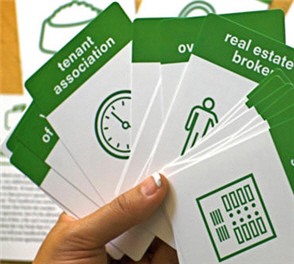
Flashcards can be an excellent learning and teaching tool especially when introducing new vocabulary or drilling familiar words. Besides being used by the teacher, they can also be used in a variety of activities and even posted around the classroom for students to reference.
How To Proceed
-
1
Introducing new vocabulary
The words on these flashcards should be in a simple font, large enough for students at the back of the classroom to see, and printed in an easy to read color. Generally the reverse side of the card would have an image or a translation. When introducing new vocabulary hold the flashcards up high enough for everyone to see and do some choral repetition with students one word at a time revealing the reverse before moving on to the next word. It is easiest when holding a set of flashcards to remove the front card and move it to the back as opposed to moving them back to front. Especially with beginners, only a handful of words should be introduced at a time. -
2
Drilling vocabulary
After introducing new vocabulary, it is a good idea to review it often. At first, pronounce each word, have students repeat each word as a class, and prompt them for the translation. This will be slower in the beginning however as they become more familiar with the words, there will be no need for you to demonstrate pronunciation or prompt them. When the students get to this stage with a set of vocabulary, challenge them by flipping through the words at a faster pace. Translations are no longer necessary. -
3
Practice
Small sets of flashcards can be used in a variety of fun activities. Here are some easy ones.
- A variation on Snap – Cards can have words, pictures, or numbers printed on one or both sides. Students play in groups of three to five. First have students spread the cards out (face up) on the desk in the middle of each group. Then simply say one vocabulary word aloud at a time. Students, upon hearing the word, must repeat it and slap the corresponding card. The student who slaps the correct card first gets to keep it and the student with the most cards in each group wins the round.
- Go fish – Cards can have printing on only one side and must be opaque. The deck must have two or four of each card depending on how many vocabulary words you would like to use. Around 50 cards in a deck would be good. Students play in groups of three to five. First have students shuffle the deck and deal five cards (face down) per student. Put the remaining cards in a pile (face down) in the middle of the desk. Students take turns asking other members of the group for cards trying to gather the necessary two or four cards of a particular word. You can make the asking and answering dialogue more or less complicated depending on your students. The simplest method is to have the student whose turn it is look directly at another student and simply say the word he is looking for. The student being asked for a card can then either respond by saying the word and handing the card over or saying “Go Fish” in which case the student whose turn it is must draw a card from the center pile.
- Memory – Cards can have printing on only one side and must be opaque. The deck must have two of each card or perhaps have an image and a word for each vocabulary word. Students play in smaller groups usually no more than four. Students should start by shuffling the cards and laying them out (face down) in a square or rectangular grid. Students take turns flipping over two cards trying to find a matching pair. If a matching pair is found, the student whose turn it is gets to keep both cards and the student with the most cards at the end of the game wins the game. -
4
Review
Before tests and quizzes, challenge your students with lots of flashcards by combining all the sets they need to review. It may be a bit overwhelming but if they have truly been building upon their knowledge during the course of their lessons, they should perform well. Difficulties with large sets of flashcards or vocabulary would suggest that they require more practice when new vocabulary is introduced and more consistent practice of words they have already learned.
There are many games, which your students are sure to enjoy, that make use of flashcards. As long as flashcards are clear and simple, they can be invaluable in your teaching.
P.S. If you enjoyed this article, please help spread it by clicking one of those sharing buttons below. And if you are interested in more, you should follow our Facebook page where we share more about creative, non-boring ways to teach English.








